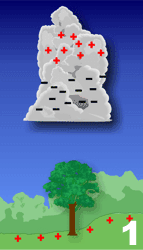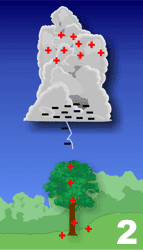- Data and Products
- Weather & Climate
- CRONOS Database
- Climate Thresholds
- Holiday Climatology
- Winter Storm Database
- Ask a Meteorologist Database
- Climate Division Data
- Climate Normals
- CRONOS API
- CRONOS Review
- Daily Normals Temperature Tool
- Data Request Form
- Environmental Modeling
- Evapotranspiration
- Heat Index Climatology
- Hurricanes Database
- NCDC Storm Events Database
- Open Water Evaporation
- Precipitation Estimates
- Storm Reports Portal
- Sunrise / Sunset Times
- Weather Extremes
- Wind Rose
- Water Resources
- Agriculture
- Forestry
- NC ECONet
- Data Request Form
- All Products
- Weather & Climate
- Aspects of NC Climate
- Educational Outreach
- About Our Office

State Climate Office of North Carolina
Email: sco@climate.ncsu.edu
Phone: 919-515-3056
Phone: 919-515-3056
Lightning
| Thunderstorms | Hail | High Winds | Tornadoes | Lightning |
| Hail by the Numbers | High Winds by the Numbers | Tornadoes by the Numbers |
Ice in a cloud seems to be a key element in the development of lightning. Storms that fail to produce quantities of ice may also fail to produce lightning. In a storm, the ice particles vary in size from small ice crystals to larger hailstones, but in the rising and sinking motions within the storm there are a lot of collisions between the particles.
These collisions cause a separation of electrical charges. Positively charged ice crystals rise to the top of the thunderstorm, and negatively charged ice particles and hailstones drop to the middle and lower parts of the storm. Enormous charge differences (electrical differential) develops.
A moving thunderstorm gathers another pool of positively charged particles along the ground that travel (image 1) with the storm. As the differences in charges continue to increase, positively charged particles rise up taller objects such as trees, houses, and telephone poles. Have you ever been under a storm and had your hair stand up? Yes, the particles also can move up you! This is one of nature's warning signs that says you are in the wrong place, and you may be a lightning target!



The negatively charged area in the storm will send out a charge toward the ground called a stepped leader (image 2). It is invisible to the human eye, and moves in steps in less than a second toward the ground. When it gets close to the ground, it is attracted by all these positively charged objects, and a channel develops (image 3). You see the electrical transfer in this channel as lightning. There may be several return strokes of electricity within the established channel that you will see as flickering lightning.
Trees and tall objects are commonly struck by lightning. The reason is the tops of these are closer to the base of the cloud than the ground and the lightning does not need to travel as far to reach the ground. However, this does not always mean tall objects will be struck. It all depends upon where the positive and negative charges collect. You are just as likely to be stuck by lightning in a field void of trees with the lightning missing the taller nearby trees.
Not all lightning forms in the negatively charged area low in the thunderstorm cloud. Some lightning originates in the cirrus anvil at the top of the thunderstorm. This area carries a large positive charge. Lightning from this area is called positive lightning. This type is particularly dangerous for several reasons.
Positively charged lightning frequently strikes away from the rain core, either ahead or behind the thunderstorm. It can strike as far as 5 or 10 miles from the storm, in areas that most people do not consider to be a lightning risk area. The other problem with positive lightning is it typically has a longer duration, so fires are more easily ignited. Positive lightning usually carries a high peak electrical current, which increases the lightning risk to an individual.
Sources and Additional Information
http://www.srh.weather.gov/jetstream/lightning/lightning_intro.htm


